
Tabernaemontana is a genus of flowering plants in the family Apocynaceae. It has a pan-tropical distribution, found in Asia, Africa, Australia, North America, South America, and a wide assortment of oceanic islands. These plants are evergreen shrubs and small trees growing to 1–15 m tall. The leaves are opposite, 3–25 cm long, with milky sap; hence it is one of the diverse plant genera commonly called "milkwood". The flowers are fragrant, white, 1–5 cm in diameter.
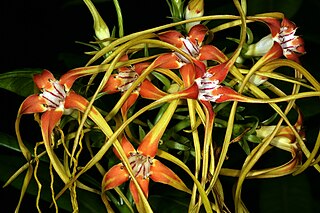
Strophanthus is a genus of flowering plants in the family Apocynaceae, first described as a genus in 1802. It is native primarily to tropical Africa, extending to South Africa, with a few species in Asia from southern India to New Guinea and southern China. The genus name is a compound of the Greek words στροφος (strophos) "twisted" and ανθοσ (anthos) "flower", in reference to the corolla lobes which, in some species - notably S. petersianus - resemble long twisted ribbons or threads and can reach a length of 30–35 cm. This trait, in addition to colouring involving combinations of bright pinks, purples and oranges, combine to make the flowers among the most ornamental in the plant kingdom.
Pycnocoma is a genus of plant of the family Euphorbiaceae first described as a genus in 1849. It is native to tropical Africa and Madagascar.

Angraecopsis is a genus of plants in the family Orchidaceae. It was first described by Fritz Kraenzlin in 1900 and given its name on account with the genus' similarity to Angraecum species. Angraecopsis are native to Africa, Madagascar, Réunion, Mauritius and the Comoros. The growth habit is rather small and the leaves emerge from a woody stem.
Hunteria is a genus of plants in the family Apocynaceae first described as a genus in 1824. It is native to Africa and to South and Southeast Asia.
- Hunteria ballayiHua - Central African Republic, Republic of Congo, Cameroon, Gabon
- Hunteria camerunensisK.Schum. ex Hallier f. - Republic of Congo, Cameroon, Gabon
- Hunteria congolanaPichon - Republic of Congo, Zaïre, Kenya
- Hunteria densifloraPichon - Zaïre
- Hunteria ghanensisJ.B.Hall & Leeuwenb. - Ivory Coast, Ghana
- Hunteria hexaloba(Pichon) Omino - Gabon
- Hunteria macrosiphonOmino - Republic of Congo, Gabon
- Hunteria myrianthaOmino - Zaïre
- Hunteria oxyanthaOmino - Republic of Congo, Zaïre, Gabon
- Hunteria simii(Stapf) H.Huber - Guinea, Ivory Coast, Liberia, Sierra Leone
- Hunteria umbellata(K.Schum) Hallier f. - W + C Africa from Senegal to Zaïre
- Hunteria zeylanica(Retz.) Gardner ex Thwaites - Somalia, Kenya, Tanzania, Mozambique, S China, India, Sri Lanka, Andaman & Nicobar Islands, Indochina, W Malaysia, Sumatra
Pleioceras is a genus of plants in the family Apocynaceae, first described as a genus in 1888. It is native to tropical Africa.
Eremospatha is a genus of climbing flowering plants in the palm family found in tropical Africa. These rattans are uncommon in cultivation and poorly understood by taxonomists. Closely related to Laccosperma, they are differentiated by the near complete absence of bracts and bracteoles. The name is from Greek meaning "without a spathe".
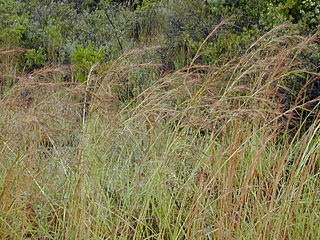
Hyparrhenia is a genus of grasses. Many species are known commonly as thatching grass.

Anchomanes is a genus of flowering plants in the family Araceae. The genus is native to tropical Africa.

Cercestis is a genus of flowering plants in the family Araceae. The species in this genus are all climbers and are native to Africa. At intervals along the stem they produce long leafless shoots called flagella. Many of the species in Cersestis show signs of fenestration.

Culcasia is a genus of flowering plants in the family Araceae, native to tropical Africa. Most of its species are climbers and resemble Cercestis, except that they do not produce flagella.
- Culcasia angolensisWelw. ex Schott - western + central Africa from Senegal to Angola
- Culcasia annetiiNtépé-Nyamè - Ivory Coast, Cameroon, Liberia
- Culcasia bosiiNtépé-Nyamè - Cameroon, Gabon, Congo-Brazzaville
- Culcasia brevipetiolataBogner - Gabon
- Culcasia caudataEngl. - Zaïre
- Culcasia dinklageiEngl - western + central Africa from Liberia to Zaïre
- Culcasia ekongoloiNtépé-Nyamè - central Africa from Nigeria to Zaïre
- Culcasia falcifoliaEngl. - central Africa from Gabon east to Tanzania and south to Mozambique
- Culcasia glandulosaHepper - Ivory Coast, Sierra Leone, Liberia, Congo-Brazzaville
- Culcasia insulanaN.E.Br. - Zaïre, Cameroon, Gulf of Guinea Islands
- Culcasia lanceolataEngl. - Cameroon, Gabon
- Culcasia libericaN.E.Br. - Ivory Coast, Sierra Leone, Liberia, Togo
- Culcasia linearifoliaBogner - Cameroon, Gabon
- Culcasia loukandensisPellegr - Cameroon, Gabon, Congo-Brazzaville, Zaïre, Central African Republic
- Culcasia mannii(Hook.f.) Engl. - Cameroon, Gabon, Congo-Brazzaville, Nigeria, Equatorial Guinea
- Culcasia obliquifoliaEngl. - Cameroon, Gabon
- Culcasia orientalisMayo - Kenya, Tanzania, Mozambique, Zambia
- Culcasia panduriformisEngl. & K.Krause - Cameroon, Gabon
- Culcasia parvifloraN.E.Br. - western + central Africa from Liberia to Zaïre
- Culcasia rotundifoliaBogner - Gabon
- Culcasia sanagensisNtépé-Nyamè - Cameroon
- Culcasia scandensP.Beauv. - western + central Africa from Liberia to Angola
- Culcasia seretiiDe Wild - western + central Africa from Liberia to Zaïre
- Culcasia simiarumNtépé-Nyamè - western Africa from Ivory Coast to Cameroon
- Culcasia striolataEngl. - western + central Africa from Liberia to Congo-Brazzaville
- Culcasia tenuifoliaEngl. - western + central Africa from Liberia to Zaïre
- Culcasia yangambiensisLouis & Mullend. - Congo-Brazzaville, Zaïre

Craterispermum is a genus of flowering plants in the family Rubiaceae. It contains 16 species that occur in tropical Africa and Seychelles. It is the only genus in the tribe Craterispermeae, of which the divergence time is estimated at 34.8 million years ago.
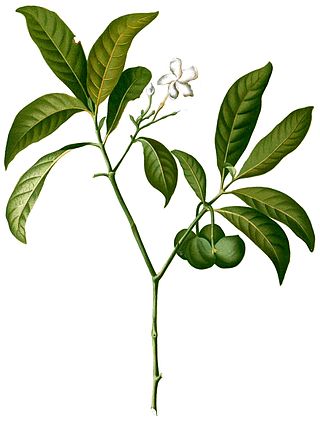
Voacanga is a genus of plants in the family Apocynaceae found in Africa, Southeast Asia, New Guinea, and Australia. As of August 2013 the World Checklist of Selected Plant Families recognises 13 species:
- Voacanga africanaStapf ex Scott-Elliot - tropical W + C + E + S Africa
- Voacanga bracteataStapf - tropical W + C Africa
- Voacanga caudifloraStapf - tropical W Africa
- Voacanga chalotianaPierre ex Stapf - tropical C Africa
- Voacanga foetida(Blume) Rolfe -Java, Borneo, Sumatra, Philippines
- Voacanga globosa(Blanco) Merr. - Philippines
- Voacanga gracilipes(Miq.) Markgr. - Maluku
- Voacanga grandifolia(Miq.) Rolfe - Indonesia, Philippines, New Guinea, Queensland
- Voacanga havilandiiRidl. - Sarawak
- Voacanga megacarpaMerr. - Philippines
- Voacanga pachycerasLeeuwenb. - Zaïre
- Voacanga psilocalyxPierre ex Stapf - Nigeria, Cameroon, Gabon, Republic of Congo
- Voacanga thouarsiiRoem. & Schult. Madagascar; widespread from Cape Province to Sudan + Senegal
- Voacanga dichotoma = Tabernaemontana pachysiphon
- Voacanga plumeriifolia = Tabernaemontana macrocarpa

Englerophytum is a group of trees in the family Sapotaceae described as a genus in 1914.
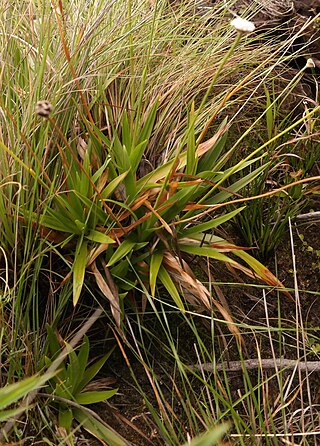
Mesanthemum is a genus of flowering plants in the family Eriocaulaceae, first described in 1856. It is native to tropical Africa and Madagascar.
Orthopichonia is a genus of plants in the family Apocynaceae, first described as a genus in 1953. It was initially given the name Orthandra, but this turned out to be an illegitimate homonym. Orthopichonia is native to Africa.
Vahadenia is a genus of flowering plants in the family Apocynaceae, first described as a genus in 1902. It is native to tropical Africa.
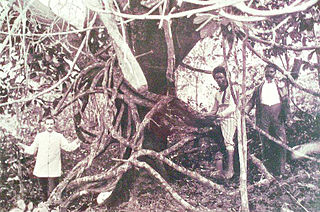
Landolphia owariensis is a species of liana from the family Apocynaceae found in tropical Africa. Latex can be extracted from this plant for the manufacture of natural rubber. Other names for this vine are eta, the white rubber vine and the Congo rubber plant. Congo rubber was a commercial rubber exported from the Congo Free State starting in 1890, most notable for its forced harvesting under conditions of great human suffering, in the Congo Free State, detailed in the 1904 Casement Report. From 1885 to 1908, millions died as a result of murder, deprivation, and disease, with population falling by millions in this period; some writers estimate this loss to be as high as 10 million people.

This is a list of the Angola national football team results from 1976 to 1999.

This article provides details of international football games played by the Zaire national football team from 1971 to 1997, when the Democratic Republic of the Congo was named Zaire.














